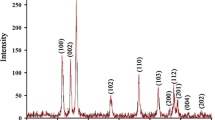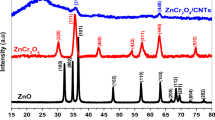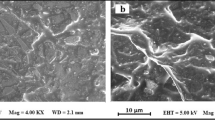Abstract
An economical and sensitive nanostructured sensor based on carbon paste electrode (CPE) for the determination of kojic acid (KA) was developed in the current work. The applied CPE was modified with 1-butyl-3-methylimidazolium tetrafluoroborate (1B3MITFB) as a conductive binder and NiO nanoparticles (NiO/NPs). The proposed modified ionic liquid-based carbon paste electrode showed satisfactory concentration range and lower detection limit of 5.0–600 μM and 0.8 μM at phosphate buffer pH 6.0, respectively. An acceptable reproducibility with a satisfactory analytical characteristic was observed for the proposed sensor in the presence of common interfering compounds. The observed irreversible oxidation behavior of KA at the surface of the NiO/NPs/1B3MITFB/MCPE was controlled under the diffusion step and the diffusion coefficient (D) at the mass transport limited rate found to be 2.3 × 10−4 cm2 s−1. According to the slope of the Tafel plot, the value of 0.625 was calculated for the electron transfer coefficient (α). The acquired data from electrochemical impedance spectroscopy studies confirmed that the presence of NiO NPS and 1B3MITFB as a conductive binder resulted in a significant increase in the electro-oxidation signal of KA. The value of 12.3 kΩ for the Rct of unmodified CPE decreased to the value of 1.7 kΩ for the modified electrode. The obtained results revealed that the proposed modified ionic liquid-based carbon paste electrode could be applied successfully for the analysis of trace amounts of KA in biological samples such as blood serum, urine, and pharmaceutical samples such as liposome carriers containing KA as well as food samples such as vinegar. The synthesized NiO nanoparticles were characterized using XRD and EDAX analyses. The morphology of NiO/NPs is further characterized by SEM.

Electro-oxidation of kojic acid.











Similar content being viewed by others
References
Wang, L., Qi, W., Su, R., & He, Z. (2014). Sensitive and efficient electrochemical determination of kojic acid in foodstuffs based on graphene-Pt nanocomposite-modified electrode. Food Analytical Methods, 7(1), 109–115.
Wang, Y., Tang, J., Luo, X., Hu, X., Yang, C., & Xu, Q. (2011). Development of a sensitive and selective kojic acid sensor based on molecularly imprinted polymer modified electrode in the lab-on-valve system. Talanta, 85(5), 2522–2527.
Nohynek, G. J., Kirkland, D., Marzin, D., Toutain, H., Leclerc-Ribaud, C., & Jinnai, H. (2004). An assessment of the genotoxicity and human health risk of topical use of kojic acid [5-hydroxy-2-(hydroxymethyl)-4H-pyran-4-one]. Food and Chemical Toxicology, 42(1), 93–105.
Shih, Y. (2001). Simultaneous determination of magnesium L-ascorbyl-2-phosphate and kojic acid in cosmetic bleaching products by using a microbore column and ion-pair liquid chromatography. Journal of AOAC International, 84(4), 1045–1049.
Huang, S.-C., Lin, C.-C., Huang, M.-C., & Wen, K.-C. (2004). Simultaneous determination of magnesium ascorbyl phosphate, ascorbyl glucoside, kojic acid, arbutin and hydroquinone in skin whitening cosmetics by HPLC. Journal of Food and Drug Analysis, 12(1).
Song, P., Xiang, Y., Xing, H., Zhou, Z., Tong, A., & Lu, Y. (2012). Label-free catalytic and molecular beacon containing an abasic site for sensitive fluorescent detection of small inorganic and organic molecules. Analytical Chemistry, 84(6), 2916–2922.
Yang, Z., Yin, Z., & Chen, F. (2011). A novel kojic acid amperometric sensor based on hollow CuO/Fe 2 O 3 hybrid microspheres immobilized in chitosan matrix. Electrochimica Acta, 56(3), 1089–1093.
Yang, X., & Zhang, H. (2007). Sensitive determination of kojic acid in foodstuffs using PVP (polyvinylpyrrolidone) modified acetylene black paste electrode. Food Chemistry, 102(4), 1223–1227.
Mohan, S., Singh, Y., Verma, D. K., & Hasan, S. H. (2015). Synthesis of CuO nanoparticles through green route using Citrus limon juice and its application as nanosorbent for Cr(VI) remediation: Process optimization with RSM and ANN-GA based model. Process Safety and Environmental Protection, 96, 156–166. https://doi.org/10.1016/j.psep.2015.05.005.
Ranjbar, M., Ali Taher, M., & Sam, A. (2015). NiO nanostructures: Novel solvent-less solid-state synthesis, characterization and MB photocatalytic degradation. Journal of Materials Science: Materials in Electronics, 26(10), 8029–8034. https://doi.org/10.1007/s10854-015-3458-5.
Asadollahzadeh, H., Ranjbar, M., & Taher, M. A. (2014). Synthesis and characterization of In2S3 nanostructures via ultrasonic method in the presence of thioglycolic acid. Journal of Industrial and Engineering Chemistry, 20(6), 4321–4326. https://doi.org/10.1016/j.jiec.2014.01.039.
Ahmadzadeh, S., Karimi, F., Atar, N., Sartori, E. R., Faghih-Mirzaei, E., & Afsharmanesh, E. (2017). Synthesis of CdO nanoparticles using direct chemical precipitation method: Fabrication of novel voltammetric sensor for square wave voltammetry determination of chlorpromazine in pharmaceutical samples. Inorganic and Nano-Metal Chemistry, 47(3), 347–353.
Zaviska, F., Drogui, P., Blais, J.-F., Mercier, G., & Lafrance, P. (2011). Experimental design methodology applied to electrochemical oxidation of the herbicide atrazine using Ti/IrO 2 and Ti/SnO 2 circular anode electrodes. Journal of Hazardous Materials, 185(2), 1499–1507.
Salavati-Niasari, M., Ranjbar, M., & Mohandes, F. (2012). Self-assembly of cubic-like nanostructures to form star-like lead sulfate microstructures. Micro and Nano Letters, 7(6), 581–584. https://doi.org/10.1049/mnl.2012.0290.
Vatanparast, M., Ranjbar, M., Ramezani, M., Hosseinpour-Mashkani, S. M., & Mousavi-Kamazani, M. (2014). Sonochemical approach for synthesis and characterization of PbTe nanostructure. Superlattices and Microstructures, 65, 365–374. https://doi.org/10.1016/j.spmi.2013.10.042.
Ahmadzadeh, S., & Dolatabadi, M. (2018). Removal of acetaminophen from hospital wastewater using electro-Fenton process. Environmental Earth Sciences, 77(2), 53. https://doi.org/10.1007/s12665-017-7203-7.
Dolatabadi, M., Mehrabpour, M., Esfandyari, M., Alidadi, H., & Davoudi, M. (2018). Modeling of simultaneous adsorption of dye and metal ion by sawdust from aqueous solution using of ANN and ANFIS. Chemometrics and Intelligent Laboratory Systems, 181, 72–78. https://doi.org/10.1016/j.chemolab.2018.07.012.
Ahmadzadeh, S., Kassim, A., Rezayi, M., Abdollahi, Y., & Rounaghi, G. H. (2011). A conductometric study of complexation reaction between meso-octamethylcalix[4]pyrrole with titanium cation in acetonitrile-ethanol binary mixtures. International Journal of Electrochemical Science, 6(10), 4749–4759.
Rezayi, M., Kassim, A., Ahmadzadeh, S., Naji, A., & Ahangar, H. (2011). Conductometric determination of formation constants of tris (2-pyridyl) methylamine and titanium (III) in water-acetonitryl mixture. International Journal of Electrochemical Science, 6, 4378–4387.
Figueiredo-Filho, L. C., Brownson, D. A., Fatibello-Filho, O., & Banks, C. E. (2013). Exploring the origins of the apparent “electrocatalytic” oxidation of kojic acid at graphene modified electrodes. Analyst, 138(16), 4436–4442.
Acknowledgments
The authors express their appreciation to the pharmaceutics research center and student research committee both affiliated to Kerman University of medical sciences, Iran, for supporting the current Pharm. D. dissertation.
Author information
Authors and Affiliations
Corresponding author
Ethics declarations
Conflict of Interest
The authors declare that they have no conflict of interests.
Research Involving Humans and Animals Statement
None
Informed Consent
None
Additional information
Publisher’s Note
Springer Nature remains neutral with regard to jurisdictional claims in published maps and institutional affiliations.
Rights and permissions
About this article
Cite this article
Avazpour, S., Pardakhty, A., Nabatian, E. et al. Economical Approach for Determination of Kojic Acid by Nanostructured Ionic Liquid-Based Carbon Paste Sensor. BioNanoSci. 10, 502–511 (2020). https://doi.org/10.1007/s12668-020-00723-3
Published:
Issue Date:
DOI: https://doi.org/10.1007/s12668-020-00723-3




